| Listing 1 - 10 of 27 | << page >> |
Sort by
|
Book
ISBN: 0804778949 9780804778947 9780804776080 0804776083 Year: 2012 Publisher: Stanford, California Stanford University Press
Abstract | Keywords | Export | Availability | Bookmark
 Loading...
Loading...Choose an application
- Reference Manager
- EndNote
- RefWorks (Direct export to RefWorks)
Nineteenth-century Britain was a world in play. The Victorians invented the weekend and built hundreds of parks and playgrounds. In the wake of Darwin, they re-imagined nature as a contest for survival. The playful child became a symbol of the future. A world in play means two things: a world in flux and a world trapped, like Alice in Wonderland, in a ludic microcosm of itself. The book explores the extent to which play (competition, leisure, mischief, luck, festivity, imagination) pervades nineteenth-century literature and culture and forms the foundations of the modern self. Pla
Book
ISBN: 9782843102301 2843102308 2843103843 Year: 2016 Publisher: Grenoble : UGA Éditions,
Abstract | Keywords | Export | Availability | Bookmark
 Loading...
Loading...Choose an application
- Reference Manager
- EndNote
- RefWorks (Direct export to RefWorks)
À travers ses portraits littéraires de poètes et de prosateurs publiés dans des revues et rassemblés en 1889 dans la première édition d'Appreciations, Walter Pater (1839-1894) propose une certaine histoire littéraire anglaise depuis le xviie siècle jusqu'à William Morris et Dante Gabriel Rossetti. Abordant une grande diversité d'oeuvres dans leur caractère créatif pour les situer dans la trajectoire intellectuelle de leurs auteurs, Pater les replace au coeur du dialogue qu'elles entretiennent avec la culture anglaise. Connu comme prosateur et critique d'art, Pater se révèle critique littéraire sensible et stimulant, élaborant ses propres conditions de canonicité tout en célébrant la langue anglaise. Les textes présentés et annotés ici sont traduits pour la première fois.
English literature --- Littérature anglaise --- History and criticism. --- Histoire et critique --- History and criticism --- Littérature anglaise --- English literature - 19th century - History and criticism --- littérature anglaise --- histoire --- critique --- XIXème siècle
Book
ISBN: 0214650820 9780214650826 Year: 1970 Volume: 6 Publisher: London Barrie and Jenkins
Abstract | Keywords | Export | Availability | Bookmark
 Loading...
Loading...Choose an application
- Reference Manager
- EndNote
- RefWorks (Direct export to RefWorks)
English literature --- History and criticism --- -British literature --- Inklings (Group of writers) --- Nonsense Club (Group of writers) --- Order of the Fancy (Group of writers) --- History and criticism. --- -History and criticism --- English literature - 19th century - History and criticism
Book
ISBN: 9789042029873 9042029870 9786612727030 9042029889 1282727036 9789042029880 9781282727038 6612727039 Year: 2010 Volume: 16 Publisher: Amsterdam New York Rodopi
Abstract | Keywords | Export | Availability | Bookmark
 Loading...
Loading...Choose an application
- Reference Manager
- EndNote
- RefWorks (Direct export to RefWorks)
The manner in which south-east Europe is viewed by western cultures has been an increasingly important area of study over the last twenty years. During the 1990's, the wars in the former Yugoslavia reactivated denigratory images of the region that many commentators perceived as a new, virulent strain of intra-European prejudice. British Literature and the Balkans is a wide-ranging and original analysis of balkanist discourse in British fiction and travel writing. Through a study of over 300 texts, the volume explores the discourse’s emergence in the imperial nineteenth century and its extensive transformations during the twentieth and twenty-first centuries. There will be a particular focus on the ways in which the most significant currents in western thought – Romanticism, empiricism, imperialism, nationalism, communism – have helped to shape the British concept of the Balkans. The volume will be of interest to those working in the area of European cross-cultural representation in the disciplines of Literary Studies, Cultural Studies, European Studies, Anthropology and History.
English literature --- History and criticism --- Balkan Peninsula --- British literature --- History and criticism. --- Balkan Peninsula. --- Balkan States --- Balkans --- Europe, Southeastern --- Southeastern Europe --- English literature - 19th century - History and criticism --- English literature - 20th century - History and criticism
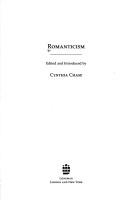
ISBN: 0582047994 0582050006 Year: 1993 Publisher: London Longman
Abstract | Keywords | Export | Availability | Bookmark
 Loading...
Loading...Choose an application
- Reference Manager
- EndNote
- RefWorks (Direct export to RefWorks)
English literature --- Romanticism --- History and criticism --- anno 1800-1899 --- Littérature anglaise --- Romantisme --- Histoire et critique --- 19th century --- Great Britain --- English literature - 19th century - History and criticism. --- Romanticism - Great Britain. --- LITTERATURE ANGLAISE --- ROMANTISME --- 19E SIECLE --- HISTOIRE ET CRITIQUE --- GRANDE-BRETAGNE
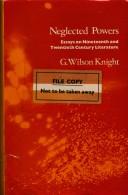
ISBN: 0710066813 9780710066817 Year: 1971 Publisher: London : Routledge & K. Paul,
Abstract | Keywords | Export | Availability | Bookmark
 Loading...
Loading...Choose an application
- Reference Manager
- EndNote
- RefWorks (Direct export to RefWorks)
English literature --- Littérature anglaise --- History and criticism --- History and criticism. --- -English literature --- -British literature --- Inklings (Group of writers) --- Nonsense Club (Group of writers) --- Order of the Fancy (Group of writers) --- -History and criticism --- Littérature anglaise --- English literature - 19th century - History and criticism --- English literature - 20th century - History and criticism --- 19e siècle --- Histoire et critique --- 20e siècle --- 19e siècle --- 20e siècle
Book

ISBN: 2878548299 2878546261 9782878546262 Year: 2018 Publisher: Paris : Presses Sorbonne Nouvelle,
Abstract | Keywords | Export | Availability | Bookmark
 Loading...
Loading...Choose an application
- Reference Manager
- EndNote
- RefWorks (Direct export to RefWorks)
C'est le paradoxe du monument moderne que ce livre se propose d'explorer. À mesure que l'enjeu de l'inscription mémorielle devient idéologiquement plus suspect, le monument se métamorphose, et l'art anglais et américain vient interroger sans relâche, par-delà le rapport à l'Histoire, les enjeux sociaux et environnementaux de la commémoration. Le marbre grec est-il blanc, le toponyme indien laisse-t-il une trace ? Construire ou décrire un monument, est-ce conforter son identité ou subtiliser la mémoire de l'autre ? Peu à peu, l'art et la littérature revisitent, brisent et transfigurent le monumental. Comment définir le monument contemporain, autrement qu'à travers ses échelles variables, du jardin de Finley au labyrinthe d'acier de Richard Serra, installations éphémères et solides à la fois ? D'où cette force proprement poétique du monument, que cette « promenade » permet d'approcher et réévaluer. This book traces the evolution of the concept of monumentality, from straightforward historical inscription to periods when such manifestations become ideologically suspect. Were Greek statues really white? Why keep monuments or Indian toponyms in the United States? Nineteenth-century British and American artists explore the construction of identity, history and nation. Gradually, monuments became landmarks of mutability as much as stability. From books and poems to works of art, twentieth and twenty-first century aesthetics revisit the monumental, from Finley's garden to Richard Serra's labyrinthine iron structures. Shape-shifting, solid yet often ephemeral, installations explore spatial and social interactions, submitting monumentality and commemoration to a welcome and long-overdue reevaluation.
English literature --- American literature --- Monuments in literature. --- Monuments in art. --- Memorials in literature. --- Memorials in art. --- History and criticism. --- English literature - 19th century - History and criticism --- American literature - 19th century - History and criticism --- Monuments in literature --- Monuments in art --- Memorials in literature --- Memorials in art --- art --- modernité --- littérature --- Royaume-Uni --- États-Unis --- monument
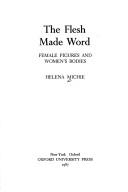
ISBN: 0195362993 1423764226 1601297459 9781423764229 9781601297457 128052426X 9781280524264 0195041070 9780195041071 0195060814 9780195060812 0197724124 Year: 1987 Publisher: New York, N.Y. Oxford University Press
Abstract | Keywords | Export | Availability | Bookmark
 Loading...
Loading...Choose an application
- Reference Manager
- EndNote
- RefWorks (Direct export to RefWorks)
Examining the works of such Victorian writers as the Brontes, Dickens, Eliot, and Hardy, this study discusses codes and taboos about the female body and explores how female sexuality was represented in Victorian literary and non-literary genres, such as painting, etiquette books and pornography.
Painting --- Thematology --- Psychological study of literature --- English literature --- anno 1800-1899 --- Feminism and literature --- Women in art --- Women in literature --- Painting, Victorian --- Body, Human, in literature --- English literature - 19th century - History and criticism --- Women in literature. --- Human body in literature. --- Women in art. --- Painting, Victorian. --- Feminism and literature. --- History and criticism.
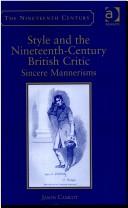
ISBN: 1351148435 1351148443 1351148427 1281332720 9786611332723 0754693546 0754692884 9780754692881 9780754693543 9780754653110 0754653110 0815397232 113862070X Year: 2008 Publisher: Aldershot, England Burlington, VT Ashgate
Abstract | Keywords | Export | Availability | Bookmark
 Loading...
Loading...Choose an application
- Reference Manager
- EndNote
- RefWorks (Direct export to RefWorks)
"In analyzing the nonfiction works of writers such as John Wilson, J.S. Mill, De Quincy, Ruskin, Arnold, Pater, and Wilde, Jason Camlot provides an important context for the nineteenth-century critic's changing ideas about style, rhetoric, and technologies of communication. In particular, Camlot contributes to our understanding of how new print media affected the Romantic and Victorian critic's sense of self, as he elaborates the ways nineteenth-century critics used their own essays on rhetoric and stylistics to speculate about the changing conditions for the production and reception of ideas and the formulation of authorial character. Camlot argues that the early 1830s mark the moment when a previously coherent tradition of pragmatic rhetoric was fragmented and redistributed into the diverse, localized sites of an emerging periodicals market. Publishing venues for writers multiplied at midcentury, establishing a new stylistic norm for criticism - one that affirmed style as the manifestation of English discipline and objectivity. The figure of the professional critic soon subsumed the authority of the polyglot intellectual, and the later decades of the nineteenth century brought about a debate on aesthetics and criticism that set ideals of Saxon-rooted 'virile' style against more culturally inclusive theories of expression."--Jacket.
English prose literature --- Criticism --- Periodicals --- English language --- Literary style --- Mannerism (Literature) --- Baroque literature --- Literature --- Style, Literary --- Language and languages --- Rhetoric --- History and criticism. --- History --- Publishing --- Rhetoric. --- Style. --- Style --- History and criticism --- English literature --- Style, Literary. --- Germanic languages --- English literature - 19th century --- Criticism - Great Britain - History - 19th century --- Periodicals - Publishing - Great Britain - History - 19th century --- English language - 19th century - Rhetoric. --- English language - 19th century - Style
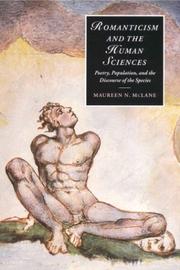
ISBN: 0521773482 0511310501 0511151144 128015473X 0511049943 0511484399 0511118511 1107119901 0511010842 9780511010842 0511034695 9780511034695 9780511118517 9780521773485 9780511484391 9780511049941 9780511151149 9781280154737 9780521028202 0521028205 Year: 2000 Publisher: Cambridge [England] New York Cambridge University Press
Abstract | Keywords | Export | Availability | Bookmark
 Loading...
Loading...Choose an application
- Reference Manager
- EndNote
- RefWorks (Direct export to RefWorks)
This study, published in 2000, examines the dialogue between Romantic poetry and the human sciences of the period. Maureen McLane reveals how Romantic writers participated in a new-found consciousness of human beings as a species, by analysing their work in relation to discourses on moral philosophy, political economy and anthropology. Writers such as Wordsworth, Coleridge, Mary Shelley and Percy Shelley explored the possibilities and limits of human being, language and hope. They engaged with the work of theorisers of the human sciences - Malthus, Godwin and Burke among them. The book offers original readings of canonical works, including Lyrical Ballads, Frankenstein and Prometheus Unbound, to show how the Romantics internalised and transformed ideas about the imagination, perfectibility, immortality and population which so energised contemporary moral and political debates. McLane provides a defence of poetry in both Romantic and contemporary theoretical terms, reformulating the predicament of Romanticism in general and poetry in particular.
English literature. --- English literature - 19th century - History and cr. --- Literature and anthropology. --- Literature and society. --- Population in literature. --- Romanticism. --- Social problems in literature. --- Social sciences. --- English literature --- Literature and society --- Literature and anthropology --- Social sciences --- Social problems in literature --- Romanticism --- Population in literature --- English Literature --- English --- Languages & Literatures --- History and criticism --- History --- History and criticism. --- Behavioral sciences --- Human sciences --- Sciences, Social --- Social science --- Social studies --- Anthropology and literature --- Civilization --- Anthropology --- Arts and Humanities --- Literature
| Listing 1 - 10 of 27 | << page >> |
Sort by
|

 Search
Search Feedback
Feedback About UniCat
About UniCat  Help
Help News
News